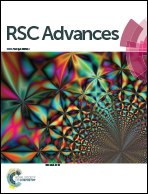Vesicle fusion intermediates obtained from the self-assembly of a cationic platinum(ii) complex with sulfonate terminated polystyrenes†
Abstract
Planar-coil supramolecular block copolymers fabricated from a cationic platinum(II) complex with sulfonate terminated polystyrenes can self-assemble into vesicles, which show further spontaneous fusion, with an hour-scale fusion time, in chloroform–methanol (v/v = 1) mixed solvents. The vesicle fusion intermediates, including docking vesicles, arrow-like protrusions, stalk-like intermediates, hemifusion diaphragms and fusion pores, are clearly imaged by transmission electron microscopy. It is proposed that such a fusion process is triggered by Pt⋯Pt and π–π stacking interactions between the platinum(II) complexes.


 Please wait while we load your content...
Please wait while we load your content...